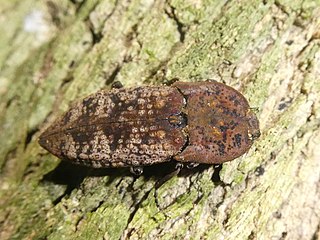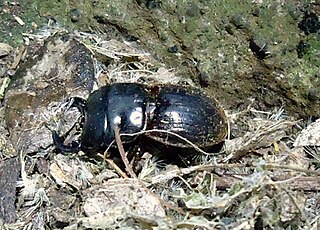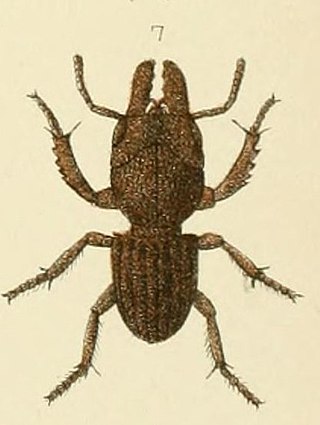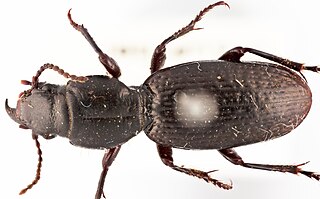
The false stag beetles (Diphyllostoma) are a group of three species of rare beetles known only from California. Almost nothing is known of their life history beyond that the adults are diurnal and females are flightless; larvae have not been observed.

Mecodema oconnori is a large-bodied species of ground beetle that is found mainly on the western regions of the North Island, New Zealand. It is mainly found in native forest habitats, both intact and fragmented, and on the edges of pine plantations. Mecodema oconnori ranges from Otaki, Kapiti Coast to Raglan, but is also found in the Manawatu Gorge and some other eastern localities.

Hadramphus, commonly known as knobbled weevils, is a genus of flightless molytine weevils from the family Curculionidae. It is endemic to New Zealand and consists of four species.

Gaioxenus is a genus of beetles in the family Carabidae. Gaioxenus pilipalpis is the only species in the genus. This genus and species was first described by Thomas Broun in 1910. Broun based the descriptions on specimens he collected in Raurimu in the Manawatū-Whanganui region of New Zealand. Gaioxenus pilipalpis is endemic to New Zealand.

Thomas Broun was a Scottish-born soldier, farmer, teacher and entomologist, who spent much of his career in New Zealand. He is known for his study of the beetles (Coleoptera) of New Zealand.

Paralissotes reticulatus, also called the New Zealand reticulate stag beetle, is a native species of stag beetle from New Zealand. Although they do have wings they are flightless.

Geodorcus helmsi, known as New Zealand giant stag beetle or Helms's stag beetle, is a large, slow-moving, flightless stag beetle in the family Lucanidae. It is endemic to New Zealand.

Amychus granulatus, commonly known as the Cook Strait click beetle, is a large flightless click beetle in the family Elateridae.

Geodorcus is a genus of beetles belonging to the family Lucanidae. They are endemic to New Zealand. All Geodorcus species are protected under Schedule 7 of The 1953 Wildlife Act, making it an offense to hunt, kill or possess a specimen.

Geodorcus capito is a large flightless species of stag beetle in the family Lucanidae. It is endemic to the Chatham Islands in New Zealand.

Geodorcus alsobius, or Moehau stag beetle, is a large flightless species of stag beetle in the family Lucanidae. It is found only on Mt Moehau, the highest mountain in the Moehau Range on the Coromandel Peninsula in New Zealand.

Geodorcus auriculatus is a large flightless stag beetle that is found in the southern part of the Coromandel Peninsula and on Mount Te Aroha in the Kaimai range of New Zealand.

Geodorcus ithaginis, the Mokohinau stag beetle, is a large flightless species of stag beetle in the family Lucanidae. It was described by Thomas Broun in 1893 after being discovered in the Mokohinau Islands by Andreas Stewart Sandager, a lighthouse keeper on the islands. The species survives only on the small unnamed island "Stack H", in a patch of vegetation the size of a living room, and is in extreme danger of extinction.
Geodorcus montivagus is a large flightless species of stag beetle in the family Lucanidae. It is known from only one female specimen found on the Victoria Range in New Zealand. It was found in tussock at 1,220 metres (4,000 ft) above sea level.

Geodorcus novaezealandiae is a large flightless species of stag beetle in the family Lucanidae. It is the type species and smallest member of the genus Geodorcus. It is endemic to New Zealand.

Geodorcus servandus is a large flightless species of stag beetle in the family Lucanidae. It was discovered by P.R. Kettle in December 1960 and this holotype specimen is held in the New Zealand Arthropod Collection. It was first described by Beverley Holloway in 2007. Its type location is Mount Tuhua summit, near Lake Kaniere on the West Coast of New Zealand. The name servandus is a Latin word meaning "[something] to be preserved, conserved, looked after".

Geodorcus sororum is a large flightless species of stag beetle in the family Lucanidae. It was discovered in 1973 by Mr. A. Wright on an expedition to Middle Sister Island/Te Awanui, one of The Sisters Islands/Rangitatahi which are part of the Chatham Islands in New Zealand. This holotype specimen is held in the New Zealand Arthropod Collection. It was first described by Beverley Holloway in 2007. The name sororum is translated from Latin to mean "belonging to the sisters".

Lyperobius hudsoni is a flightless weevil found in alpine areas of Central Otago and Otago Lakes in the South Island of New Zealand.

Mecodema longicolle is an endemic New Zealand ground beetle, and one of the few Mecodema species found in both the North Island and South Island.

Paralissotes is a genus of stag beetle that is endemic to New Zealand.



















